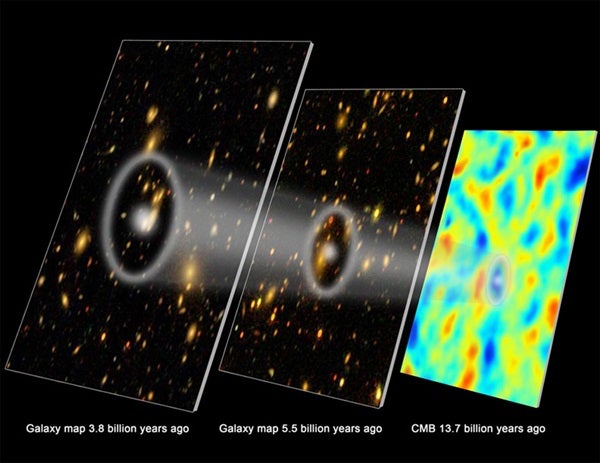The new measurement came from the Baryon Oscillation Spectroscopic Survey (BOSS), which is part of the third Sloan Digital Sky Survey (SDSS-III).
“We see the influence of dark energy on cosmic structure, but we have no idea what it is. The data gathered by this survey will help answer that question,” said Daniel Eisenstein from the Harvard-Smithsonian Center for Astrophysics in Cambridge, Massachusetts.
“There’s been a lot of talk about using galaxy maps to find out what’s causing accelerating expansion,” said David Schlegel from the U.S. Department of Energy’s Lawrence Berkeley National Laboratory in California, BOSS’s principal investigator. “We’ve been making a map, and now we’re using it — starting to push our knowledge out to the distances when dark energy turned on.”
Investigating Dark Energy
One of the most amazing discoveries of the last two decades in astronomy, recognized with the 2011 Nobel Prize in physics, was that not only is our universe expanding, but it also is accelerating. Galaxies are becoming farther apart from each other faster and faster with time.
The leading contender for the cause of the accelerating expansion is a postulated new property of space dubbed “dark energy.” Alternatively, the universe may be accelerating because gravity deviates from Einstein’s general theory of relativity and becomes repulsive at very large distances.
Whether the answer to the puzzle of the accelerating universe is dark energy or modified gravity, the first step to finding that answer is to measure accurate distances to as many galaxies as possible. From those measurements, astronomers can trace out the history of the universe’s expansion.
BOSS is producing the most detailed map of the universe ever made by using a new custom-designed spectrograph of the SDSS 2.5-meter telescope at Apache Point Observatory in New Mexico to observe more than a million galaxies over six years.
The astronomers’ announcement is based on a map of more than 250,000 galaxies created from the first year and a half of BOSS observations. Some of these galaxies are so distant that their light has traveled more than 6 billion years to reach Earth — nearly half the age of the universe.
Surveying the Cosmos
Maps of the universe like BOSS’s show that galaxies and clusters of galaxies are clumped together into walls and filaments, with giant voids between. These structures grew out of subtle variations in density in the early universe, which bore the imprint of “baryon acoustic oscillations” — pressure-driven acoustic (sound) waves that passed through the early universe.
Billions of years later, the record of these sound waves can still be read in our universe. “Because of the regularity of the ancient sound waves, there’s a slightly increased probability that any two galaxies today will be separated by about 500 million light-years, rather than 400 million or 600 million,” said Eisenstein.
In a graph of the number of galaxy pairs by separation distance, that magic number of 500 million light-years shows up as a peak, so astronomers often speak of the “peak separation.” The position of this peak depends on the amount of dark energy in the universe. But measuring the distance between galaxies depends critically on having the right distances to the galaxies in the first place.
That’s where BOSS comes in. “We’ve detected the peak separation more clearly than ever before,” said Nikhil Padmanabhan of Yale University. “These measurements allow us to determine the contents of the universe with unprecedented accuracy.”










